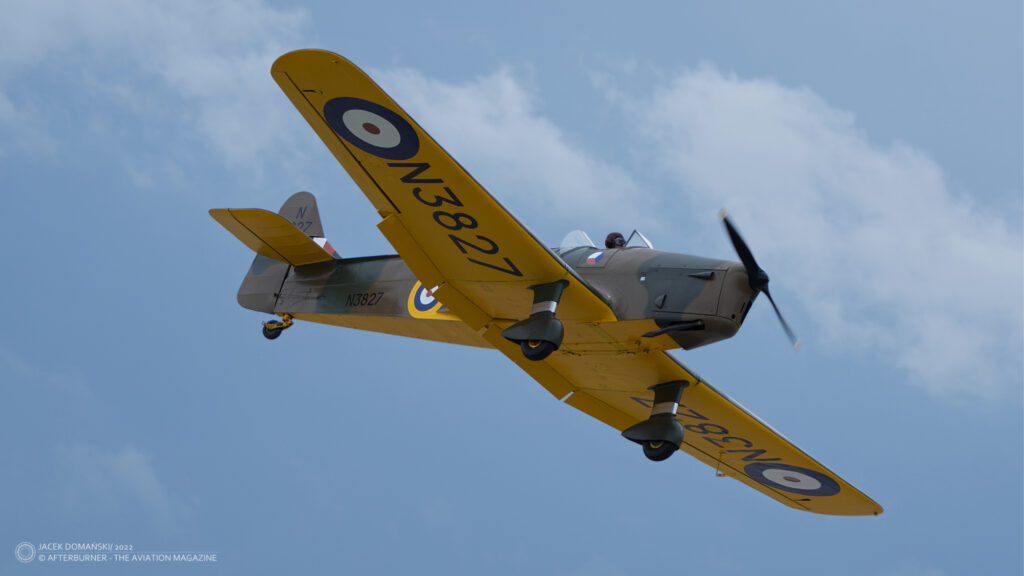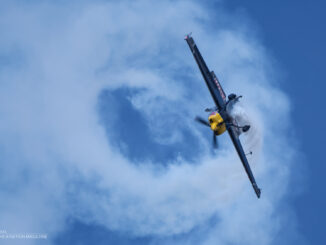 Miles M.14A Magister I / Hawk Trainer III (c/n 873, G-CLHY, formerly N3827 of the RAF / LV-XSG), flying display at 30th edition of Aviation Fair air show, Pardubice, May 2022.
Miles M.14A Magister I / Hawk Trainer III (c/n 873, G-CLHY, formerly N3827 of the RAF / LV-XSG), flying display at 30th edition of Aviation Fair air show, Pardubice, May 2022.
In order to tell the story of Miles Magister aircraft, we must go back to 1932. Late that year, Frederick George Miles and Charles Powys discussed the idea of creating a two-seat, low-wing monoplane that could be offered at a discounted, affordable price. That discussion led to development of Miles Hawk (initially designated Ibex), light aeroplane that performed its maiden flight on 29th March 1933.
The Hawk was nicely designed monoplane with great performance and price below £400. That was more than enough to achieve commercial success and about fifty aircraft were sold in a relatively short time. Depending on particular variant, the Hawks were equipped with different de Havilland or Aircraft Disposal Company engines.
In 1934, Miles introduced an upgraded variant of the Hawk, powered by de Havilland Gipsy Major engine and designated Hawk Major. More than sixty aircraft of that type were sold. One of the most significant achievements of the Hawk Major was its participation in MacRobertson Air Race – flown by S/L McGregor, the aeroplane covered more than 11,000 miles long route from RAF Mildenhall to Australia in 7 days and 15 hours and became the fastest single-engine aircraft of the race.
One year later, F.G. Miles proposed another upgrade of his design, known as M.2 Hawk Trainer. The aeroplane was intended for initial pilot training and to create an alternative for de Havilland Tiger Moth. The Hawk Trainer met with considerable interest of the Air Ministry and led to issue of Specification T.40/36 that covered in more detail the air force requirements for such type of aircraft. In the meantime, the Hawk Trainer was approved by the Air Ministry, to be the first elementary training monoplane within the RAF.
On 20th March 1937, the first prototype of the new aircraft performed its maiden flight, flown by F.G. Miles himself. Shortly thereafter, the aeroplane received its official designation M.14 Magister. The new trainer featured double controls, blind flying equipment and enlarged cockpit. It was so well received by pilots and instructors that soon afterwards was approved by the Air Ministry – as the first low-wing monoplane in the RAF ever – to perform aerobatics.
Before the war, approximately 700 Magister trainers were manufactured and delivered to flying clubs and the RAF flying schools, as well as sold to foreign customers. In the eve of the World War II, the Miles Magister became one of the most important training aircraft within the British and Commonwealth military aviation. It was widely used by both the RAF and the Fleet Air Arm, being considered as perfect trainer for future fighter pilots. The aircraft was in production until 1941 with a total number of built Magisters exceeding 1,300 examples (including some made under license in Turkey). After the war, most of the RAF Magisters were retired, and then being both sold to private operators or just scrapped.
The Miles M.14A Magister Mk.I pictured above was manufactured in 1938 and flew with N3827 identification number, being operated by different RAF flying schools until the end of the war. Then it was retired from military service and sold to Argentina, where it stayed until 2019. In that year, the aircraft was bought by RAF Station Czechoslovakia association and ferried to its new home airfield in Podhořany u Ronova.
The aircraft was then sent to England for renovation that was successfully finalized in spring of 2022. On 16th May that year, the restored Magister Mk.I landed at Podhořany airfield. Just two weeks later, the aeroplane was for the first time shown to the Czech public during the 30th edition of Aviation Fair air show in Pardubice, where it participated in both flying and static displays.



